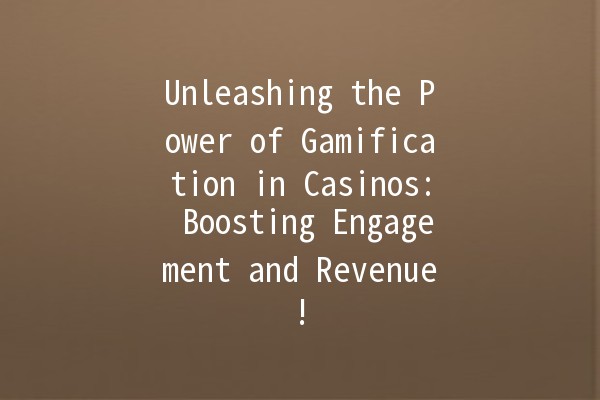In the everevolving world of entertainment, casinos are translating traditional gaming into dynamic experiences enriched by gamification. This article delves deep into how gamification not only captivates customers but also enhances operational efficiency, driving revenue while maintaining compliance and ethical standards.
Understanding Gamification and Its Relevance to Casinos
Gamification refers to the application of game design elements and principles in nongame contexts, which can incite human motivation through engaging activities. In the competitive arena of casinos, incorporating gamification is becoming not just a trend but a necessity, enabling operators to create memorable experiences that captivate players.
The Importance of Gamification in Modern Casinos
Modern casinos face fierce competition from online platforms and other leisure activities. Gamification offers several benefits:

SectorSpecific Applications of Gamification in Casinos
Gamification can manifest in various elements of casino operations, including:
Slot Machines: Modern slot games that incorporate storylines, missions, and rewards enhance the player's gaming experience, providing a more immersive environment.
Table Games: Interactive leaderboards and minigames within table gaming can offer players more than just the typical betting experience.
Mobile Apps: Many casinos are creating their own applications to provide interactive content, loyalty programs, and minigames, encouraging players to stay engaged even when they aren’t physically at the casino.
Five Effective Tips for Implementing Gamification in Casinos
Let's now explore practical tips that can significantly improve gamification strategies in casinos.
Explanation: A tiered rewards system allows players to unlock benefits as they achieve specific milestones, enhancing player engagement.
Application: For example, a casino could implement a loyalty program where customers earn points for every dollar wagered. As they accrue points, they can climb to higher tiers that offer escalating rewards such as exclusive game access, complimentary meals, or hotel stays. This structure incentivizes players to continually engage with the casino.
Explanation: Social interactions enrich gaming experiences. By using social challenges, players can compete against one another, fostering community.
Application: Casinos could host weekly tournaments where players compete on specific slot machines or table games. Players will earn points based on their performance, and top players can win prizes. This not only creates a competitive edge but also brings players together, enhancing their overall experience.
Explanation: Leaderboards exhibit performance metrics of players, fostering a competitive environment that can drive engagement.
Application: Casinos can establish realtime leaderboards that display players' rankings based on various metrics, such as winstreaks or total playtime. A leaderboard can occupy a prominent space within the gaming floor or be integrated into the casino app, encouraging players to strive for better rankings.
Explanation: Incorporating narrative elements into games can captivate players, making the gaming experience more compelling.
Application: Slot machines and electronic table games can deliver storylines that unfold as players engage. For example, players might embark on a treasure hunt where they unlock story progress with every game played or every milestone reached. This narrative connection adds depth and excitement to their experience.
Explanation: By bridging gaming with other entertainment activities, casinos can create a holistic experience.
Application: A casino might offer a ‘game night’ where players earn points for dining or attending shows. Integration with other services can draw in participants who may not typically engage in gaming but may enjoy entertainment and cuisine.
Integrating gamification in casinos has the potential to transform the player experience by fostering engagement, enhancing loyalty, and driving revenue. By implementing strategies such as tiered rewards, social competitions, interactive leaderboards, engaging storylines, and holistic crosspromotions, casino operators can stay ahead in a highly competitive landscape.
The future of casinos remains dynamic and exciting with gamification leading the way toward stronger customer loyalty and sustained growth. As technology advances and consumer preferences evolve, those in the casino industry who embrace gamification strategies will be better equipped to thrive in this transformative era.
Frequently Asked Questions
What is gamification, and how is it applied in casinos?
Answer: Gamification is incorporating gamelike elements in nongaming contexts to boost engagement. In casinos, it includes reward systems, competitions, and interactive features that enrich the gaming experience and encourage player participation.
How can gamification improve customer retention in casinos?
Answer: By offering tiered rewards, social competitions, and engaging content, gamification fosters a sense of belonging among players. When players feel recognized and rewarded for their loyalty, they are more likely to return, enhancing customer retention.
What types of games benefit most from gamification?
Answer: Slots and table games are most commonly enhanced through gamification. Interactive features make these games more appealing as they cater to player preferences for competition and engagement. Mobile casino apps also benefit significantly from gamified features.
Can gamification be effectively integrated into online casinos?
Answer: Yes, gamification can be seamlessly incorporated into online casino platforms. Features such as leaderboard competitions, loyalty rewards, and interactive multiplayer experiences can create an engaging online environment, similar to physical casinos.
What are the common pitfalls of implementing gamification in casinos?
Answer: Common pitfalls include overcomplicating the user experience, failing to align game mechanics with player preferences, and neglecting technological infrastructure. Casinos must ensure that gamification enhances the experience rather than distracts from the main gaming activities.
How does gamification contribute to the revenue of casinos?
Answer: By increasing player engagement and loyalty, gamification directly contributes to higher spending and repeat visits. Engaged players are more likely to spend more on games, merge additional services, and promote the casino to others, ultimately boosting revenue.
By leveraging these insights into gamification strategies in casinos, the gaming industry can continue to innovate and provide unparalleled experiences that draw players in and keep them coming back for more.